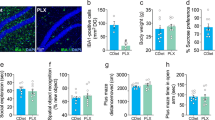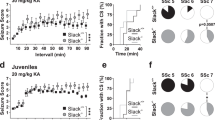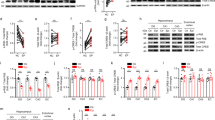Abstract
Myristoylated alanine-rich C kinase substrate (MARCKS) is a widely distributed protein kinase C (PKC) substrate and has been implicated in actin cytoskeletal rearrangement in response to extracellular stimuli. Although MARCKS was extensively examined in various cell culture systems, the physiological function of MARCKS in the central nervous system has not been clearly understood. We investigated alterations of cellular distribution and phosphorylation of MARCKS in the hippocampus following kainic acid (KA)-induced seizures. KA (25 mg/kg, i.p.) was administered to eight to nine week-old C57BL/6 mice. Behavioral seizure activity was observed for 2 h after the onset of seizures and was terminated with diazepam (8 mg/kg, i.p.). The animals were sacrificed and analyzed at various points in time after the initiation of seizure activity. Using double-labeling immunofluorescence analysis, we demonstrated that the expression and phosphorylation of MARCKS was dramatically upregulated specifically in microglial cells after KA-induced seizures, but not in other types of glial cells. PKC α, β I, β II and δ, from various PKC isoforms examined, also were markedly upregulated, specifically in microglial cells. Moreover, immunoreactivities of phosphorylated MARCKS were co-localized in the activated microglia with those of the above isoforms of PKC. Taken together, our in vivo data suggest that MARCKS is closely linked to microglial activation processes, which are important in pathological conditions, such as neuroinflammation and neurodegeneration.
Similar content being viewed by others
Article PDF
Author information
Authors and Affiliations
Rights and permissions
This is an Open Access article distributed under the terms of the Creative Commons Attribution Non-Commercial License (http://creativecommons.org/licenses/by-nc/3.0/) which permits unrestricted non-commercial use, distribution, and reproduction in any medium, provided the original work is properly cited.
About this article
Cite this article
Eun, SY., Kim, E., Kang, KS. et al. Cell type-specific upregulation of myristoylated alanine-rich C kinase substrate and protein kinase C-α, -β I, -β II, and -δ in microglia following kainic acid-induced seizures. Exp Mol Med 38, 310–319 (2006). https://doi.org/10.1038/emm.2006.37
Published:
Issue date:
DOI: https://doi.org/10.1038/emm.2006.37
Keywords
This article is cited by
-
Effect of rottlerin on astrocyte phenotype polarization after trimethyltin insult in the dentate gyrus of mice
Journal of Neuroinflammation (2022)
-
MARCKS and MARCKS-like proteins in development and regeneration
Journal of Biomedical Science (2018)
-
Changes of Src-suppressed C kinase substrate expression in cytokine induced reactive C6 glioma cells
Neuroscience Bulletin (2007)
-
Src suppressed C kinase substrate regulates the lipopolysaccharide-induced TNF-α biosynthesis in rat astrocytes
Journal of Molecular Neuroscience (2007)



